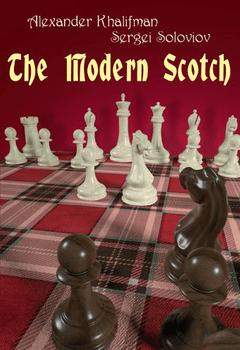| Nivå | C-D |
| Utgivelsesdato | August 2019 |
| Forfatter | |
| Pris | 285 NOK |
The Modern Scotch
Et nytt sterkt standardverk om å spille Skotsk med hvit: 1 e4 e5 2 Sf3 Sc6 3 exd4 4 Sxd4. Khalifman leverer som i sine tidligere bøker høy kvalitet. Repertoaret hans avviker etter 4... Lc5 fra det mest spilte 5 Le3 med i stedet 5 Sb3 som begrenser svarts motspill.
Forlagets egen omtale
The Scotch Game is the most “open” of all the Open Games. In fact this is the only really Open Game, in its essence, which matches the traditional terminology.
The move 3.d2-d4 breaks immediately the symmetry. White tries to occupy the centre and gain additional space. Rapid contact between the opposing forces takes place, in fact much quicker than in the other open (and not only open...) games, which increases the value of every move and requires from both sides tremendous accuracy at a very early stage of the game. Positions with opposite castles arise much more often in the Scotch than in all the other Open Games put together.
Alexander Khalifman is a GM and FIDE Senior Trainer, FIDE World Chess Champion in 1999. He won the Soviet Union Youth Championship (1982, 1984), the European Under-20 Championship (1985), the Russian Championship (1996). He was a member of the gold medal-winning Russian team at the Chess Olympiads in 1992, 2000 and 2002, and at the 1997 World Team Chess Championship. Author of many books as Opening for White According to Anand, Opening for White According to Kramnik.
Sergei Soloviov is an IM, author of many books as Boris Spassky's 400 Selected Games, Leko's One Hundred Wins.
Fra forfatterens forord
So, little by little, a solution was found. The most “open” of all the Open Games turned out to be the Scotch Game. I am presenting it to you with this book. I believe that nowadays this is the only really Open Game, in its essence, which matches the traditional terminology.
I can anticipate that some people will not agree with me. What about the King’s Gambit and or the Danish Gambit? These are much more open. This is true, I agree, but both of these, along with various other inventions of the romantic age of chess, are unsuited to the pragmatic tendencies of contemporary chess at the top level. My classical chess education has programmed me to look for an opening advantage with White and in the above-mentioned gambits exactly which side would be fighting for an advantage would be far from clear...
So what led to my decision about the Scotch Game? This is in fact a rhetorical question. It is the move 3.d2-d4, which departs immediately from the symmetry in the opening; White tries to occupy the centre and gain additional space. Black also has his resources though, and the details of this opening struggle will be covered in this book with all due attention.
Rapid contact between the opposing forces takes place, in fact much quicker than in the other open (and not only open...) games, which increases the value of every move and requires from both sides tremendous accuracy at a very early stage of the game. There is another factor to be taken into account. The opening struggle is also characterised by the fact that positions with castling on opposite sides arise much more often in the Scotch than in all the other Open Games put together. There are no compromises in a fight of this type and the outcome of the game is often decided by direct attacks against the enemy king.
| Innbundet? | Nei |
| Type | Bok |
| Språk | Engelsk |
| Antall sider | 527 |

